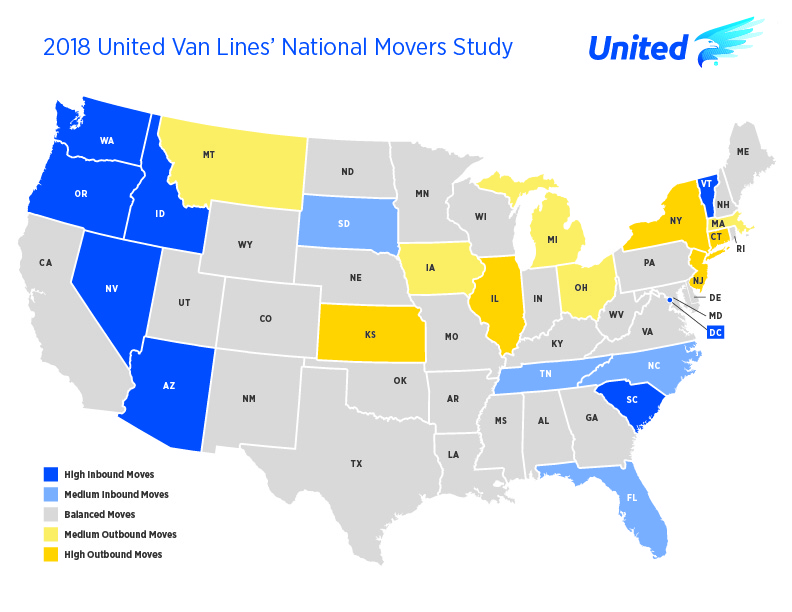Moving From Houston To Connecticut
Making the decision to relocate from Houston, Texas to Connecticut can be a daunting task, especially considering the vastly different climates, cultures, and lifestyles of these two regions. As you prepare to trade in the cowboy boots and southern hospitality of Houston for the charming colonial towns and picturesque autumn foliage of Connecticut, it's essential to know what to expect. From navigating the varying costs of living to understanding the unique job markets and housing options, this guide will provide you with the insider knowledge necessary to make a seamless transition to your new life in Connecticut.

- Embracing the Change: Moving from Houston to Connecticut
- Is moving to Connecticut a good idea?
- How much does it cost to move from Texas to Connecticut?
- Why are people moving away from Connecticut?
- Is Connecticut a state a good place to live?
- Is Connecticut a Good Place to Live?
- FAQ
- What are the main differences in cost of living between Houston and Connecticut?
- How do I navigate the job market in Connecticut compared to Houston?
- What are the best ways to get around Connecticut, especially if I'm not used to the cold winters?
- How do I adjust to the different climate and seasonal changes in Connecticut compared to Houston?
Embracing the Change: Moving from Houston to Connecticut
Moving from Houston to Connecticut can be a significant change, but with proper planning and knowledge, it can be a smooth and exciting transition. Here are some key things to consider when making this move:
Climate Differences: Preparing for the Northeast Weather
One of the most notable differences between Houston and Connecticut is the climate. Houston's humid subtropical climate means hot summers and mild winters, whereas Connecticut's humid continental climate means cold winters and warm summers. Be prepared for potential snowfall and freezing temperatures during the winter months, and invest in warm clothing and gear to stay cozy. On the other hand, enjoy the mild springs and autumns that Connecticut has to offer.
Cost of Living: Understanding the Financial Differences
The cost of living in Connecticut is significantly higher than in Houston. Be prepared for higher taxes, housing costs, and living expenses. However, Connecticut's higher average income and lower unemployment rate may offset some of these costs. It's essential to create a budget and factor in these differences to ensure a smooth financial transition.
Housing Options: Finding the Right Place to Call Home
Connecticut offers a range of housing options, from apartments to single-family homes. Depending on your preferences and budget, you may find yourself in a bustling city like New Haven or a quiet suburb like Greenwich. Research different areas and neighborhoods to find the best fit for you and your family.
Job Opportunities: Leveraging Connecticut's Strong Economy
Connecticut is home to a diverse range of industries, including healthcare, finance, and manufacturing. The state is also known for its strong startup scene and innovation hubs. With a highly educated workforce and a strong economy, there are many job opportunities available. Update your resume, network, and be prepared to take advantage of the many career opportunities Connecticut has to offer.
Culture Shock: Adapting to the New England Lifestyle
Moving to Connecticut can be a cultural shock, especially for those who are not familiar with the New England lifestyle. Be prepared for a more fast-paced and densely populated environment, as well as a strong sense of community and history. Take time to explore your new surroundings, try new foods, and get involved in local events to make the most of your new home.
| Category | Houston | Connecticut |
|---|---|---|
| Climate | Humid subtropical | Humid continental |
| Cost of Living | Lower | Higher |
| Average Income | $61,465 | $78,833 |
| Unemployment Rate | 3.9% | 3.6% |
Is moving to Connecticut a good idea?

Moving to Connecticut can be a good idea for various reasons, but it's essential to weigh the pros and cons before making a decision.
Pros of Moving to Connecticut
Connecticut offers a high quality of life, excellent education system, and a strong economy. Here are some benefits of moving to Connecticut:
High standard of living: Connecticut is one of the wealthiest states in the country, with a high median household income and low poverty rate.
Excellent education: The state is home to some of the top-ranked universities and schools in the country, including Yale University and the University of Connecticut.
Strong economy: Connecticut has a diverse economy with major industries in healthcare, finance, and manufacturing, providing numerous job opportunities.
Cons of Moving to Connecticut
Despite its many advantages, moving to Connecticut also has its drawbacks. Here are some things to consider:
High cost of living: Connecticut is one of the most expensive states to live in, with high housing costs, taxes, and living expenses.
Traffic and congestion: The state's proximity to New York City and Boston can lead to heavy traffic and congestion, making commuting challenging.
Weather: Connecticut's climate can be quite unpredictable, with cold winters and hot summers, which may not appeal to everyone.
Things to Consider Before Moving to Connecticut
Before making the move to Connecticut, here are some essential factors to consider:
Research different areas: Connecticut has varying regions, each with its unique character and lifestyle. Research areas like coastal towns, rural communities, and urban centers to find the best fit for you.
Job opportunities: Connecticut has a strong economy, but it's crucial to research job opportunities in your field and the cost of living in different areas.
Culture and lifestyle: Connecticut offers a unique blend of rural and urban living, with a rich cultural scene and plenty of outdoor activities. Consider whether this lifestyle appeals to you.
How much does it cost to move from Texas to Connecticut?
The cost of moving from Texas to Connecticut can vary greatly depending on several factors such as the distance, weight, and type of items being moved, as well as the services required. Here's a breakdown of the estimated costs:
Average Moving Costs
The average cost of a long-distance move from Texas to Connecticut can range from $2,000 to $5,000 or more, depending on the specifics of the move.
Factors Affecting Moving Costs
Several factors can influence the overall cost of moving from Texas to Connecticut. These include:
- Distance: The farther the move, the higher the cost. Connecticut is approximately 1,770 miles from Texas, which can increase the cost of fuel, tolls, and labor.
- Weight and Volume: The more items being moved, the heavier the load, and the higher the cost. This includes furniture, boxes, and other belongings.
- Type of Move: Whether you're moving a studio apartment or a large house, the type of move will impact the cost. Studio apartments typically require fewer resources and are less expensive, while larger homes require more labor and equipment.
Moving Services and Costs
The cost of moving services can vary depending on the type of service and provider. Here are some estimated costs for different moving services:
- Full-Service Moves: This type of move includes packing, loading, transporting, and unloading your belongings. The cost can range from $2,500 to $5,000 or more, depending on the weight and distance of the move.
- Portable Container Moves: This type of move involves packing your belongings into a portable container, which is then transported to your new location. The cost can range from $1,500 to $3,000 or more, depending on the container size and distance.
- Rental Truck Moves: This type of move involves renting a truck and doing the moving yourself. The cost can range from $1,000 to $2,500 or more, depending on the truck size, fuel, and equipment rentals.
Additional Moving Expenses
In addition to the moving costs, there may be additional expenses to consider, such as:
- Packing Materials: If you choose to pack your belongings yourself, you'll need to purchase packing materials such as boxes, bubble wrap, and tape. The cost can range from $100 to $500 or more, depending on the quantity and quality of materials.
- Insurance: Moving insurance can provide protection against loss or damage to your belongings during the move. The cost can range from $100 to $500 or more, depending on the policy and coverage.
- Tolls and Parking: If you're driving a rental truck or using a moving container, you may need to pay tolls and parking fees along the way. The cost can range from $100 to $500 or more, depending on the route and distance.
Why are people moving away from Connecticut?

Connecticut, a state known for its picturesque towns, rich history, and proximity to New York City, has seen a decline in population in recent years. According to data from the United States Census Bureau, Connecticut has been experiencing a net loss of residents since 2016, with approximately 20,000 people leaving the state in 2020 alone. So, what's driving this exodus?
Tax Burden and High Cost of Living
One of the primary reasons people are fleeing Connecticut is the high cost of living, particularly when it comes to taxes. Connecticut has some of the highest property taxes in the country, with the average homeowner paying over $6,000 per year. Additionally, the state has a high income tax rate, which can be as high as 7%. This can be a significant burden for residents, especially those on fixed incomes or with lower salaries.
• High property taxes discourage people from owning homes
• High income tax rates make it difficult for individuals to save money
• The high cost of living makes it hard for families to afford basic necessities
Lack of Job Opportunities and Stagnant Economy
Another major factor contributing to the population decline is the lack of job opportunities and a stagnant economy. While Connecticut is home to many major corporations, including insurance giants like Aetna and The Hartford, the state has struggled to create new jobs and stimulate growth. The state's economy has been slow to recover from the 2008 recession, and the unemployment rate remains higher than the national average.
• Limited job opportunities in key industries such as manufacturing and technology
• Stagnant wages and limited career advancement opportunities
• The state's reliance on old industries hinders innovation and growth
Changing Demographics and Aging Population
Finally, Connecticut's demographics are also shifting, contributing to the population decline. The state's population is aging rapidly, with a high median age and a low birth rate. This means there are fewer young people entering the workforce or starting families, leading to a decline in population.
• Low birth rates and aging population lead to a shrinking workforce
• Fewer young people are staying in the state to raise families
• The state's demographics are becoming less diverse, making it less attractive to certain individuals
Is Connecticut a state a good place to live?

Is Connecticut a Good Place to Live?
Connecticut is a state located in the northeastern region of the United States, known for its rich history, scenic coastline, and high standard of living. While it's often overlooked by neighboring states like New York and Massachusetts, Connecticut has a lot to offer its residents. Here are some reasons why Connecticut can be a great place to live:
Pros of Living in Connecticut
One of the biggest advantages of living in Connecticut is its strong economy. The state has a diverse range of industries, including finance, healthcare, and manufacturing, which provides a high level of job security and opportunities for advancement. Additionally, Connecticut is home to many top-ranked universities, including Yale University and the University of Connecticut, which offer excellent education options.
Here are some more pros of living in Connecticut:
- The state has a high median household income, with many residents enjoying a comfortable standard of living.
- Connecticut has a low unemployment rate, making it an attractive option for job seekers.
- The state has a rich cultural scene, with numerous museums, art galleries, and historical landmarks to explore.
Cons of Living in Connecticut
While Connecticut has many advantages, it's not without its drawbacks. One of the biggest cons is the high cost of living, with steep housing costs and high taxes. Additionally, the state's traffic and congestion can be frustrating, especially during rush hour.
Here are some more cons of living in Connecticut:
- The state has harsh winters, with cold temperatures and heavy snowfall.
- Connecticut's property taxes are some of the highest in the country.
- The state's crime rate is higher than the national average in some areas.
Best Places to Live in Connecticut
While Connecticut is a small state, it has many unique towns and cities to choose from, each with its own character and charm. Here are some of the best places to live in Connecticut:
Here are some of the best places to live in Connecticut:
- Stamford: A vibrant city with a strong economy and a diverse range of cultural attractions.
- New Haven: Home to Yale University and a thriving arts and cultural scene.
- Greenwich: An affluent town with a high standard of living and excellent schools.
FAQ
What are the main differences in cost of living between Houston and Connecticut?
The cost of living in Connecticut is significantly higher compared to Houston. Housing costs in Connecticut, particularly in cities like Stamford and Hartford, are much higher than in Houston. The median home price in Connecticut is around $270,000, whereas in Houston it's around $190,000. Additionally, taxes in Connecticut are also higher, with a state income tax rate ranging from 3% to 6.99%, whereas Texas has no state income tax. However, it's worth noting that Connecticut offers a higher average salary, which can help offset the increased cost of living.
While both Houston and Connecticut have strong job markets, the industries and job opportunities differ significantly. Houston is a hub for the energy industry, with many major oil and gas companies headquartered there. In contrast, Connecticut is known for its financial and insurance industries, with many major companies, such as Aetna and The Hartford, based in the state. If you're moving to Connecticut, it's essential to research the job market in your field and network with professionals in your industry to find job opportunities. Additionally, consider the commute time and transportation options in Connecticut, as they may be different from what you're used to in Houston.
What are the best ways to get around Connecticut, especially if I'm not used to the cold winters?
Connecticut has a well-developed public transportation system, including buses and trains, which can be a convenient option for getting around, especially during the winter months. The Metro-North Railroad connects major cities like Stamford and Hartford to New York City, making it easy to commute to work or explore the region. If you prefer to drive, be sure to winterize your vehicle and invest in snow tires to navigate the snowy roads safely. Additionally, consider investing in a four-wheel-drive vehicle if you plan to drive frequently during the winter.
How do I adjust to the different climate and seasonal changes in Connecticut compared to Houston?
The climate in Connecticut is significantly different from Houston's warm and humid subtropical climate. Connecticut experiences cold winters with heavy snowfall, mild springs, and warm summers. To adjust to the changing seasons, be sure to pack warm clothing, including a heavy coat, gloves, and hats. Additionally, invest in a snow blower or shovel to clear your driveway and sidewalks during the winter months. It's also essential to winterize your home by insulating your pipes and preparing your heating system for the cold weather. With some preparation and planning, you can quickly adjust to the changing seasons in Connecticut.